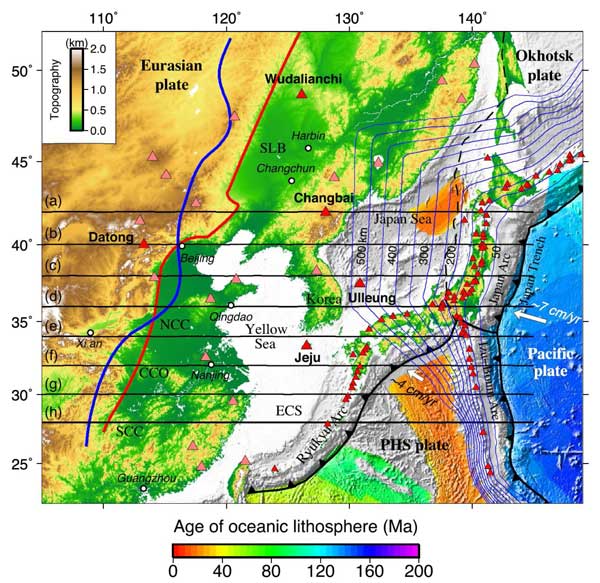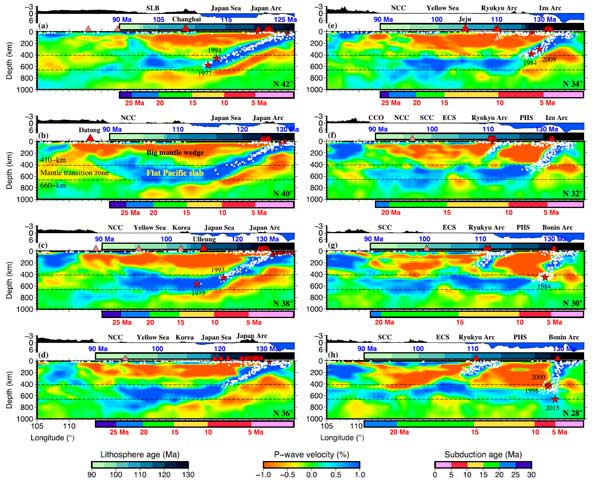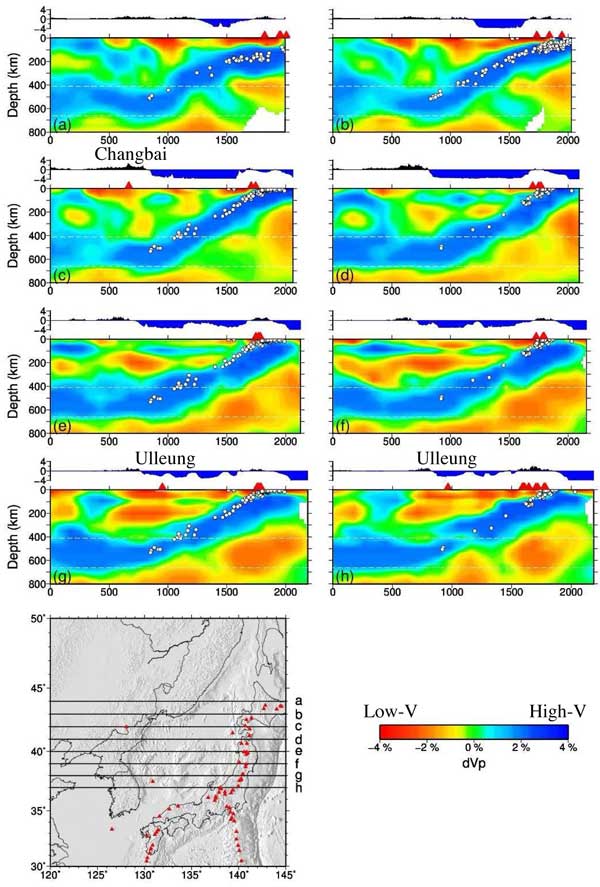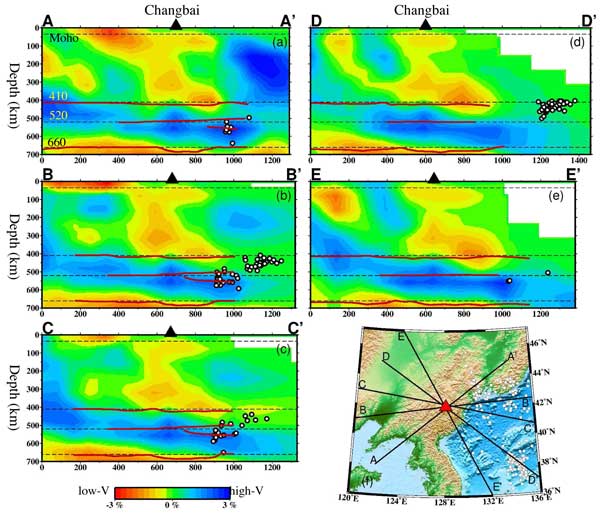 |
Big mantle wedge and intraplate volcanism in Northeast Asia |
Dapeng Zhao
Department of Geophysics, Tohoku University, Sendai 980-8578, Japan, zhao@tohoku.ac.jp
Several Cenozoic intraplate volcanoes exist in Northeast Asia (Figure 1). Among these volcanoes Changbai is the largest and most active. It lies at the border between China and North Korea approximately 1300 km from the Japan Trench (Figure 1). Intraplate volcanism in NE Asia contrasts with arc volcanism resulting from subducting slab dehydration and mantle wedge melting (e.g., Hasegawa & Zhao, 1994; Iwamori & Zhao, 2000), the “hotspot” volcanism which may be caused by deep-rooted mantle plumes (e.g., Morgan, 1971), and some upper-mantle processes (e.g., Foulger, 2010). It is, instead, considered to be caused by hot and wet upwelling in the big mantle wedge (BMW) above the Pacific slab which is currently stagnant in the mantle transition zone (MTZ) beneath the Korean Peninsula and East China (e.g., Zhao, 2004; Zhao et al., 2004, 2007, 2009; Lei & Zhao, 2005; Richard & Iwamori, 2010; Kuritani et al., 2011; Kameyama & Nishioka, 2012; Zhao & Tian, 2013; Tian et al., 2016; Choi et al., 2017; He, 2017; Su et al., 2017). Tomographic models on regional and global scales have clearly imaged the high-velocity (high-V) stagnant slab in the MTZ and low-velocity (low-V) anomalies in the BMW beneath NE Asia (e.g., Fukao et al., 2001; Zhao, 2004; Huang & Zhao, 2006; Wei et al., 2012, 2015) (Figure 2). Receiver-function studies have revealed localized depth variations of the 410- and 660-km discontinuities (d410 and d660) (e.g., Li & Yuan, 2003; Lee et al., 2014; Tian et al., 2016). SS precursors and triplicated phases associated with the MTZ discontinuities are also used to study the stagnant slab thickness and geophysical properties (e.g., Tajima et al., 2009; Ye et al., 2011; Gu et al., 2012; Li et al., 2013; Dokht et al., 2016).

Figure 1. Tectonic setting of East Asia (Liu et al., 2017). The red triangles denote active volcanoes. The pink triangles denote locations of the Cenozoic basalts. The thin blue lines denote depth contours of the present upper boundary of the subducting Pacific slab estimated from seismicity. The thick red line shows a gravity anomaly boundary. The thick blue line shows the western edge of the flat Pacific slab in the mantle transition zone (MTZ) estimated from the tomographic model shown in Figure 2. The eight black lines denote locations of the vertical cross-sections shown in Figure 2. The solid sawtooth lines and the black dashed line denote the plate boundaries. SLB, the Songliao Basin; NCC, the North China Craton; CCO, the Central China Orogen; SCC, the South China Craton; ECS, the East China Sea; PHS, the Philippine Sea. Click here or on image for enlargement.

Figure 2. Vertical cross-sections of P-wave tomography along the eight profiles shown in Figure 1. The red and blue colors denote low- and high-velocity perturbations, respectively, whose scale (in %) is shown at the bottom-middle. The color bar with blue numbers above each cross-section shows the subducting Pacific lithosphere ages from west (East China) to east (near the Japan Trench), whose scale (in Ma) is shown at the bottom-left. The surface topography along each profile is shown above the lithosphere age bar. The color bar with red numbers below each cross-section shows the subduction ages of the Pacific slab, whose scale (in Ma) is shown at bottom-right. The red and pink triangles above each cross-section denote locations of active volcanoes and Cenozoic basalts, respectively, within a 1° width of each profile. The background seismicity and large earthquakes (M ≥ 7.0) that occurred within a 1° width of each profile are shown by white circles and red stars, respectively. The two black dashed lines denote the 410- and 660-km discontinuities. After Liu et al. (2017). Click here or on image for enlargement.
Several seismological studies of NE Asia have been made recently using data recorded by a portable seismic network (NECESSArray) deployed in NE China 2009 to 2011. A tomographic model obtained from teleseismic relative travel times recorded by the NECESSArray shows a low-V anomaly within the stagnant slab. This was interpreted as a slab gap (Tang et al., 2014). However, other tomographic models obtained from absolute P- and S travel times show higher velocities in the slab there, and so do not support the existence of the so-called slab gap (Takeuchi et al., 2014; Wei et al., 2015; Chen et al., 2017). Teleseismic tomography using relative travel-time data is a popular and widely used tool for studying the upper-mantle structure (e.g., Aki et al., 1977; Lei & Zhao, 2005; Zhao et al., 2004, 2009; Tang et al., 2014). However, this method has an inherent limitation which is that the background mean velocity in the study volume is removed during the computation of relative travel times. Thus, teleseismic tomography alone is unable to recover the real shape of a network-wide feature in a given depth range beneath a local seismic network (e.g., Bastow, 2012), such as the wide and flat stagnant slab in the MTZ beneath NE Asia (Chen et al., 2017). This limitation could be compensated by simultaneous inversion of teleseismic relative travel-time residuals and absolute arrival-time data of local earthquakes (e.g., Zhao et al., 2009) or by adding surface-wave data (e.g., Liu & Zhao, 2016).
Chen et al. (2017) investigated 3-D Vp and Vs structures of the mantle down to a depth of 800 km beneath NE Asia using many arrival-time data of local earthquakes and teleseismic events recorded at 2388 stations of permanent and portable seismic networks deployed in NE China, Japan and South Korea (Figure 3). Their results do not support the existence of a gap or hole in the stagnant slab beneath the Changbai volcano. They conducted joint inversions of both local-earthquake arrival times and teleseismic relative travel-time residuals, leading to a robust tomographic model of the upper mantle and the MTZ beneath NE Asia (Figure 3). Their joint inversion results reveal clearly the subducting Pacific slab beneath the Japan Islands and the Japan Sea, as well as the stagnant slab in the MTZ beneath the Korean Peninsula and NE China (Figure 3). Localized low-V anomalies are revealed clearly in the crust and the BMW directly beneath the active Changbai and Ulleung volcanoes (Figures 3c, 3g and 3h). This is interpreted as the intraplate volcanism resulting from hot, wet upwelling in the BMW associated with corner flow in the BMW and deep slab dehydration. To the west of the Changbai volcano, the stagnant slab exhibits a slightly lower Vp than that of the surrounding parts of the slab (Figures 2 and 3), suggesting the existence of lateral heterogeneities in the slab. These may result from several factors such as differences in slab age (Figure 2; Liu et al., 2017), compositional variations in the slab due to hotspot magmatism in the Paleo-Pacific Ocean, e.g., Hawaii, and oceanic fracture zones in the Paleo-Pacific lithosphere (Liu et al., 2017).

Figure 3. East–west vertical cross-sections of P-wave tomography along the eight profiles shown in the inset map (Chen et al., 2017). The red and blue colors denote low and high velocities, respectively. The velocity perturbation scale (in %) is shown at the bottom. The red triangles denote active volcanoes. The two white dashed lines denote the 410- and 660 km discontinuities. The white dots denote seismicity within 30 km of each profile.
Tian et al. (2016) investigated the detailed MTZ structure beneath the active Changbai volcano applying a receiver-function method to teleseismic waveforms recorded at many local seismic stations deployed around the Changbai volcano. Their results reveal significant depth variations of the d410 and d660 as well as the 520 km discontinuity (d520) (Figure 4). A broad d410 depression and a low-V anomaly are revealed beneath the Changbai volcano, which may reflect hot mantle upwelling around the d410 with a positive Clapeyron slope. The d520 is also identified clearly, and its uplift occurs above the stagnant Pacific slab. Tian et al. (2016) also find a prominent depression of the d660 (Figure 4), which is elongated along the trend of deep earthquake clusters in a range of 39°N–44°N latitude, and the depressed area has a lateral extent of ~400 km. Because the d520 and d660 correspond to positive and negative Clapeyron slopes, respectively, the d520 uplift and the d660 depression should be caused by the cold Pacific slab. This high-resolution receiver-function study supports the BMW model for the formation of the Changbai intraplate volcano (Tian et al., 2016). A prominent feature of the d520 is that two separate phases show up to the east of the Changbai volcano, where deep earthquakes occur (Figure 4a–4c). Deuss & Woodhouse (2001) obtained a similar result using SS precursors in the same area, and they suggested that the two d520 phases are related to anomalies of temperature and water content, as well as large-scale chemical heterogeneities.

Figure 4. (a–e) Vertical cross-sections of P-wave tomography along the five profiles shown in the map (f). The red and blue colors denote the slow and fast velocity perturbations (in %), respectively, whose scale is shown at the bottom. The four dashed lines show the Moho, 410-, 520- and 660-km discontinuities. The red solid lines represent the geometries of the 410-, 520- and 660-km discontinuities obtained by a teleseismic receiver-function study. The black and red triangles denote the Changbai intraplate volcano. The white dots denote deep earthquakes within 30-km of each profile. Modified from Tian et al. (2016).
In summary, most (if not all) of the geophysical, petrologic and geochemical studies made so far support the BMW model for explaining the intraplate volcanism in NE Asia.
References
-
Aki, K., Christofferson, A., Husebye, E., 1977. Determination of the three-dimensional seismic structure of the lithosphere. Journal of Geophysical Research 82, 277–296.
-
Bastow, I., 2012. Relative arrival-time upper-mantle tomography and the elusive background mean. Geophysical Journal International 190, 1271–1278.
-
Chen, C., Zhao, D., Tian, Y., Wu, S., Hasegawa, A., Lei, J., Park, J., Kang, I., 2017. Mantle transition zone, stagnant slab and intraplate volcanism in Northeast Asia. Geophysical Journal International 209, 68-85.
-
Choi, H., Choi, S., Schiano, P., Cho, M., 2017. Geochemistry of olivine-hosted melt inclusions in the Baekdusan (Changbaishan) basalts: Implications for recycling of oceanic crustal materials into the mantle source. Lithos 284, 194-206.
-
Deuss, A., Woodhouse, J., 2001. Seismic observations of splitting of the mid-transition zone discontinuity in Earth’s mantle. Science 294, 354–357.
-
Dokht, R., Gu, Y.J., Sacchi, M., 2016. Waveform inversion of SS precursors: an investigation of the northwestern Pacific subduction zones and intraplate volcanoes in China. Gondwana Research 40, 77–90.
-
Foulger, G.R., 2010. Plates vs Plumes: A Geological Controversy. Wiley-Blackwell, pp. 352.
-
Fukao, Y., Widiyantoro, S., Obayashi, M., 2001. Stagnant slabs in the upper and lower mantle transition region. Reviews of Geophysics 39, 291-323.
-
Gu, Y., Okeler, A., Schultz, R., 2012. Tracking slabs beneath northwestern Pacific subduction zones. Earth and Planetary Science Letters 331, 269–280.
-
Hasegawa, A., Zhao, D., 1994. Deep structure of island arc magmatic regions as inferred from seismic observations. Magmatic Systems (edited by M.P. Ryan), Academic Press, pp. 179-195.
-
He, L., 2017. Wet plume atop of the flattening slab: Insight into intraplate volcanism in East Asia. Physics of the Earth and Planetary Interiors 269, 29-39.
-
Huang, J., Zhao, D., 2006. High-resolution mantle tomography of China and surrounding regions. Journal of Geophysical Research 111, B09305.
-
Iwamori, H., Zhao, D., 2000. Melting and seismic structure beneath the northeast Japan arc. Geophysical Research Letters 27, 425-428.
-
Kameyama, M., Nishioka, R., 2012. Generation of ascending flows in the Big Mantle Wedge (BMW) beneath northeast Asia induced by retreat and stagnation of subducted slab. Geophysical Research Letters 39, L10309.
-
Kuritani, T., Ohtani, E., Kimura, J., 2011. Intensive hydration of the mantle transition zone beneath China caused by ancient slab stagnation. Nature Geoscience 4, 713-716.
-
Lee, S., Rhie, J., Park, Y., Kim, K., 2014. Topography of the 410 and 660 km discontinuities beneath the Korean Peninsula and southwestern Japan using teleseismic receiver functions. Journal of Geophysical Research 119, 7245–7257.
-
Lei J., Zhao, D., 2005. P-wave tomography and origin of the Changbai intraplate volcano in Northeast Asia. Tectonophysics 397, 281-295.
-
Li, J., Wang, X., Wang, X., Yuen, D., 2013. P and SH velocity structure in the upper mantle beneath Northeast China: evidence for a stagnant slab in hydrous mantle transition zone. Earth and Planetary Science Letters 367, 71-81.
-
Li, X., Yuan, X., 2003. Receiver functions in northeast China: implications for slab penetration into the lower mantle in northwest Pacific subduction zone. Earth and Planetary Science Letters 216, 679–691.
-
Liu, X., Zhao, D., 2016. P and S wave tomography of Japan subduction zone from joint inversions of local and teleseismic travel times and surface-wave data. Physics of the Earth and Planetary Interiors 252, 1-22.
-
Liu, X., Zhao, D., Li, S., Wei, W., 2017. Age of the subducting Pacific slab beneath East Asia and its geodynamic implications. Earth and Planetary Science Letters 464, 166-174.
-
Morgan, W., 1971. Convection plumes in the lower mantle, Nature 230, 42–43.
-
Richard, G., Iwamori, H., 2010. Stagnant slab, wet plumes and Cenozoic volcanism in East Asia. Physics of the Earth and Planetary Interiors 183, 280–287.
-
Su, B., Hu, Y., Teng, F., Xiao, Y., 2017. Magnesium isotope constraints on subduction contribution to Mesozoic and Cenozoic East Asian continental basalts. Chemical Geology, in press.
-
Tajima, F., Katayama, I., Nakagawa, T., 2009. Variable seismic structure near the 660 km discontinuity associated with stagnant slabs and geochemical implications. Physics of the Earth and Planetary Interiors 172, 183–198.
-
Takeuchi, N. et al., 2014. Upper mantle tomography in the northwestern Pacific region using triplicated P waves. Journal of Geophysical Research 119, 7667–7685.
-
Tian, Y., Zhu, H., Zhao, D., Liu, C., Feng, X., Liu, T., Ma, J., 2016. Mantle transition zone structure beneath the Changbai volcano: Insight into deep slab dehydration and hot upwelling near the 410-km discontinuity. Journal of Geophysical Research 121, 5794-5808.
-
Tang, Y. et al., 2014. Changbaishan volcanism in northeast China linked to subduction-induced mantle upwelling, Nature Geoscience 7, 470–475.
-
Wei, W., Xu, J., Zhao, D., Shi, Y., 2012. East Asia mantle tomography: New insight into plate subduction and intraplate volcanism. Journal of Asian Earth Sciences 60, 88-103.
-
Wei, W., Zhao, D., Xu, J., Wei, F., Liu, G., 2015. P and S wave tomography and anisotropy in Northwest Pacific and East Asia: Constraints on stagnant slab and intraplate volcanism. Journal of Geophysical Research 120, 1642-1666.
-
Ye, L., Li, J., Tseng, T., Yao, Z., 2011. A stagnant slab in a water bearing mantle transition zone beneath northeast China: implications from regional SH waveform modeling. Geophysical Journal International 186, 706-710.
-
Zhao, D., 2004. Global tomographic images of mantle plumes and subducting slabs: insight into deep Earth dynamics. Physics of the Earth and Planetary Interiors 146, 3-34.
-
Zhao, D., Tian, Y., 2013. Changbai intraplate volcanism and deep earthquakes in East Asia: A possible link? Geophysical Journal International 195, 706-724.
-
Zhao, D., Lei, J., Tang, R., 2004. Origin of the Changbai intraplate volcanism in Northeast China: Evidence from seismic tomography. Chinese Science Bulletin 49, 1401-1408.
-
Zhao, D., Maruyama, S., Omori, S., 2007. Mantle dynamics of western Pacific to East Asia: New insight from seismic tomography and mineral physics. Gondwana Research 11, 120-131.
-
Zhao, D., Tian, Y., Lei, J., Liu, L., Zheng, S., 2009. Seismic image and origin of the Changbai intraplate volcano in East Asia: Role of big mantle wedge above the stagnant Pacific slab. Physics of the Earth and Planetary Interiors 173, 197-206.
last updated 14th
September, 2017 |
